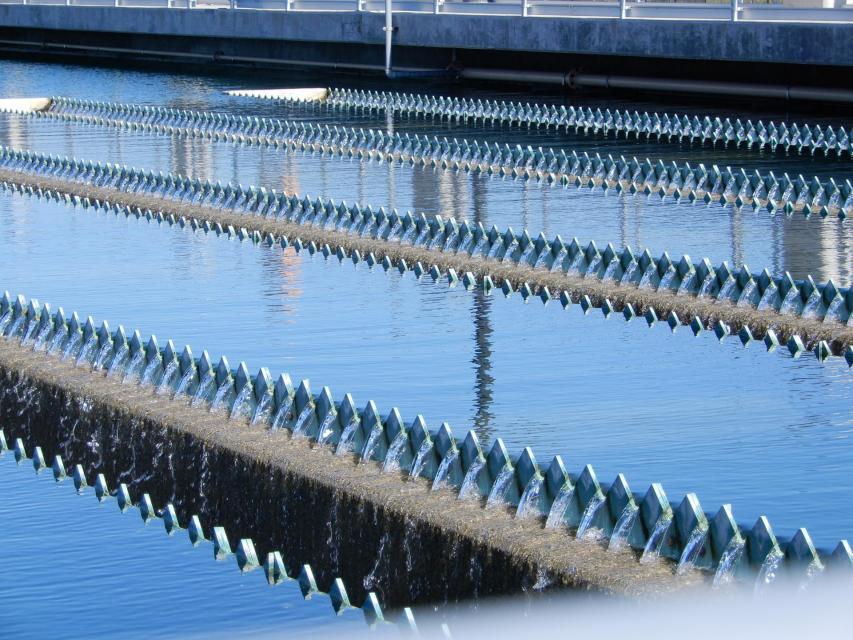How is Drinking Water Treated?
 Nearly a century ago, controlling
water-borne disease was the main treatment goal of water
providers. Today, water agencies large and small provide their
customers with the highest quality drinking water in the world.
Before disinfection became a common practice, widespread
outbreaks of cholera and typhoid were frequent throughout the
United States. These diseases are still common in less developed
countries, but largely disappeared in the United States when
chlorine and filtration became widely used 80 years ago.
Nearly a century ago, controlling
water-borne disease was the main treatment goal of water
providers. Today, water agencies large and small provide their
customers with the highest quality drinking water in the world.
Before disinfection became a common practice, widespread
outbreaks of cholera and typhoid were frequent throughout the
United States. These diseases are still common in less developed
countries, but largely disappeared in the United States when
chlorine and filtration became widely used 80 years ago.
Before disinfection became a common practice, widespread outbreaks of cholera and typhoid were frequent throughout the United States.
A tremendous amount of time and technology is expended to make surface water safe to drink. At the treatment plant, it is put through many processes before it reaches a consumer’s tap.
Water treatment technology must deal with a number of potential perils resulting from the movement of water from its source to our tap. Mountain springs might flow through sulfur, zinc or arsenic-laden formations. Groundwater can pick up contamination from fertilizers, septic tanks, mine drainage, naturally occurring minerals, industrial chemicals and metals such as arsenic and chromium. Rivers and streams sometimes carry harmful microorganisms from animals or humans, presenting a risk of disease. Storm drains can carry polluted runoff from cities into rivers and streams.
U.S. drinking water supplies are heavily regulated. Public and private water suppliers operating treatment systems today have methods to control nearly all of the properties found in water: hardness, acidity and alkalinity, color, turbidity, taste and odor, as well as the biological and organic chemical characteristics. Large water suppliers have their own laboratories to test water while smaller agencies use commercial labs.
In some systems, fluoride is added to reduce tooth decay. California law requires fluoridation of water in systems with 10,000 or more connections if outside funding is provided. According to the state, 30 percent of all public water providers in California fluoridate their water.
The treatment of groundwater varies from community to community, and even from well to well within a city depending on contaminants in the water. The water may be treated as it is pumped from the ground to remove certain contaminants or it may be chlorinated if there is concern of bacterial or parasitic infection.
The driving force behind the development of drinking water standards and regulations is the protection of public health. Many laws have been adopted concerning water quality standards, going as far back as the Interstate Quarantine Act of 1893, which sought to control the introduction of communicable diseases from other countries. The first drinking water regulations prohibited the use of a common drinking cup on trains.
The first federal drinking water standard, adopted in 1914, was limited to bacteriological quality of water and not physical and chemical requirements. By 1925, cities were using filtration, chlorination or both and had little difficulty complying with the coliform standard. Eventually, limits were established for lead, copper, zinc and excessive soluble mineral substances. In 1941, an advisory committee of federal agency representatives, scientific associations and at-large members was formed to revise drinking water regulations. In 1942, the committee agreed on significant initiatives such as required bacteriological examinations in water distribution systems and maximum concentrations for lead, fluoride, arsenic and selenium. Twenty years later, the U.S. Public Health Service developed drinking water standards that were used by California.
During the following decades, federal water pollution control efforts focused on physical, biological, chemical and industrial waste. Passed by Congress in 1974, the Safe Drinking Water Act (SDWA) regulates drinking water quality in the United States. Under the SDWA, the U.S. Environmental protection Agency (EPA) can delegate implementation of drinking water regulations to states that have developed programs at least as stringent as the federal one. Such states, including California, have primary enforcement responsibility for administering their own programs.
Under the SDWA, public water systems are required to conduct testing on a regular basis. Monthly monitoring for microbial contaminants is required for both surface water and groundwater systems, while organic chemical monitoring must be conducted annually by surface systems and every three years by groundwater systems.
Contaminants fell into several categories: those that occur naturally, such as arsenic and uranium, those that are manmade, such as solvents or pesticides; and those that derive primarily from the materials used in supplying water, most notably disinfection byproducts (DBPs). The byproducts emerge from the treatment process when chlorine reacts with naturally occurring organic compounds found in the water supply. Public health experts note the possible risks from DBPs are limited compared to inadequate disinfection of drinking water.
EPA established pollutant-specific minimum testing schedules for public water systems. If a problem is detected, there are immediate retesting requirements that go into effect and strict instructions for how the system informs the public about the problem. Until the system can reliably demonstrate that it is free of problems, the retesting is continued.








